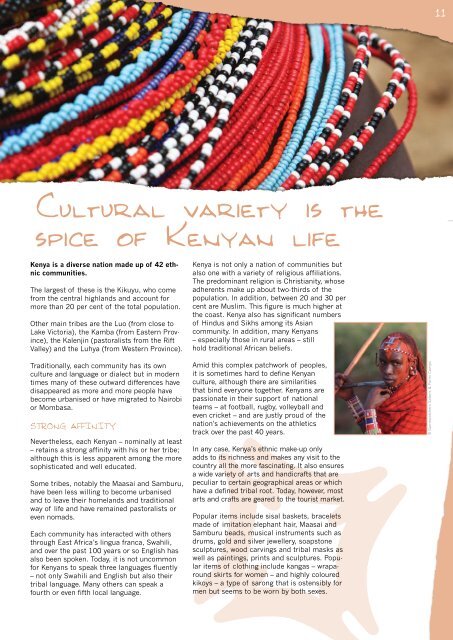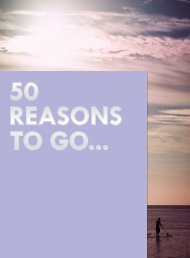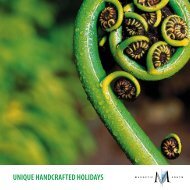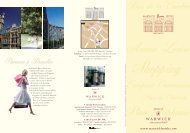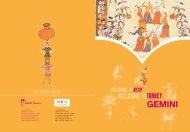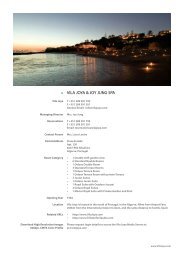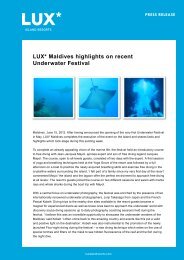Kenya Travel Guide & Manual - International Luxury Travel Market
Kenya Travel Guide & Manual - International Luxury Travel Market
Kenya Travel Guide & Manual - International Luxury Travel Market
You also want an ePaper? Increase the reach of your titles
YUMPU automatically turns print PDFs into web optimized ePapers that Google loves.
Cultural variety is the<br />
spice of <strong>Kenya</strong>n life<br />
<strong>Kenya</strong> is a diverse nation made up of 42 ethnic<br />
communities.<br />
The largest of these is the Kikuyu, who come<br />
from the central highlands and account for<br />
more than 20 per cent of the total population.<br />
Other main tribes are the Luo (from close to<br />
Lake Victoria), the Kamba (from Eastern Province),<br />
the Kalenjin (pastoralists from the Rift<br />
Valley) and the Luhya (from Western Province).<br />
Traditionally, each community has its own<br />
culture and language or dialect but in modern<br />
times many of these outward differences have<br />
disappeared as more and more people have<br />
become urbanised or have migrated to Nairobi<br />
or Mombasa.<br />
STRONG AFFINITY<br />
Nevertheless, each <strong>Kenya</strong>n – nominally at least<br />
– retains a strong affinity with his or her tribe;<br />
although this is less apparent among the more<br />
sophisticated and well educated.<br />
Some tribes, notably the Maasai and Samburu,<br />
have been less willing to become urbanised<br />
and to leave their homelands and traditional<br />
way of life and have remained pastoralists or<br />
even nomads.<br />
Each community has interacted with others<br />
through East Africa’s lingua franca, Swahili,<br />
and over the past 100 years or so English has<br />
also been spoken. Today, it is not uncommon<br />
for <strong>Kenya</strong>ns to speak three languages fluently<br />
– not only Swahili and English but also their<br />
tribal language. Many others can speak a<br />
fourth or even fifth local language.<br />
<strong>Kenya</strong> is not only a nation of communities but<br />
also one with a variety of religious affiliations.<br />
The predominant religion is Christianity, whose<br />
adherents make up about two-thirds of the<br />
population. In addition, between 20 and 30 per<br />
cent are Muslim. This figure is much higher at<br />
the coast. <strong>Kenya</strong> also has significant numbers<br />
of Hindus and Sikhs among its Asian<br />
community. In addition, many <strong>Kenya</strong>ns<br />
– especially those in rural areas – still<br />
hold traditional African beliefs.<br />
Amid this complex patchwork of peoples,<br />
it is sometimes hard to define <strong>Kenya</strong>n<br />
culture, although there are similarities<br />
that bind everyone together. <strong>Kenya</strong>ns are<br />
passionate in their support of national<br />
teams – at football, rugby, volleyball and<br />
even cricket – and are justly proud of the<br />
nation’s achievements on the athletics<br />
track over the past 40 years.<br />
In any case, <strong>Kenya</strong>’s ethnic make-up only<br />
adds to its richness and makes any visit to the<br />
country all the more fascinating. It also ensures<br />
a wide variety of arts and handicrafts that are<br />
peculiar to certain geographical areas or which<br />
have a defined tribal root. Today, however, most<br />
arts and crafts are geared to the tourist market.<br />
Popular items include sisal baskets, bracelets<br />
made of imitation elephant hair, Maasai and<br />
Samburu beads, musical instruments such as<br />
drums, gold and silver jewellery, soapstone<br />
sculptures, wood carvings and tribal masks as<br />
well as paintings, prints and sculptures. Popular<br />
items of clothing include kangas – wraparound<br />
skirts for women – and highly coloured<br />
kikoys – a type of sarong that is ostensibly for<br />
men but seems to be worn by both sexes.<br />
© Gamewatchers Safaris & Porini Camps


